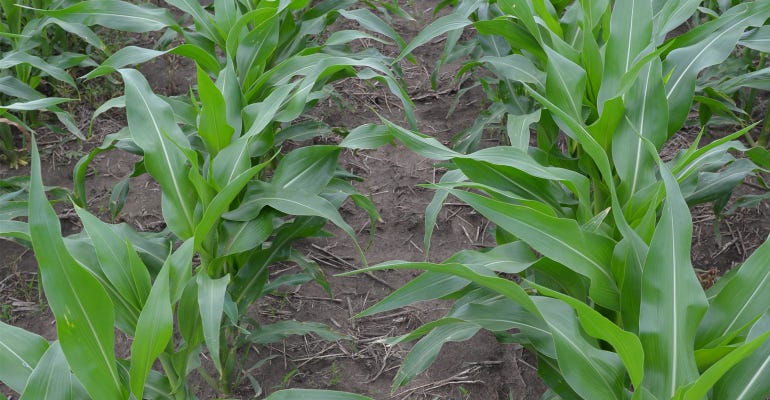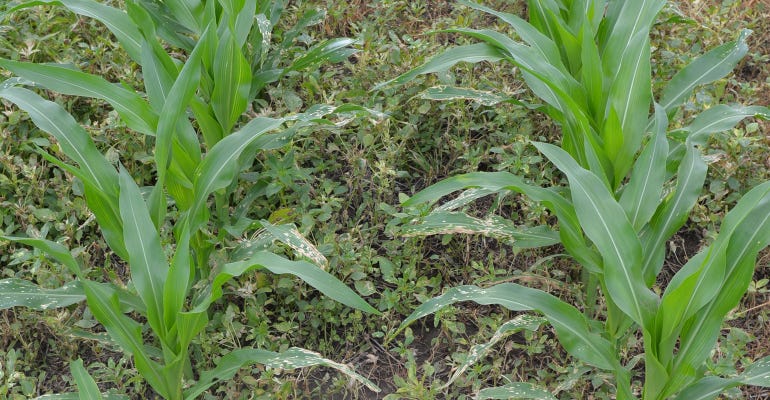
Under ideal conditions, growers apply a preemergence residual herbicide early in the growing season, when weeds such as Palmer amaranth and waterhemp haven't yet had a chance to emerge.
However, during years like 2019, heavy rains throw a wrench in applicators' plans, delaying herbicide applications and allowing weed escapes. The question is, for those situations where preemergence applications aren't possible, what are your best options for a postemergence application?
In 2019, Amit Jhala, Nebraska Extension weed management specialist, conducted a research trial on a field near Carleton, comparing different postemergence herbicide on corn. This project, supported by the Nebraska Corn Board and Bayer Crop Science, is taking place on a 10-acre field with a population of Palmer amaranth resistant to glyphosate, ALS inhibitors and atrazine.
Jhala discussed the project in a recent virtual resistant Palmer amaranth field day available on the University of Nebraska-Lincoln's website.
"This isn't under ideal conditions, but rescue conditions — however, you can provide control of those Palmer amaranth plants where a preemergence herbicide wasn't applied," Jhala says. "We applied herbicides early postemergence when Palmer amaranth plants were somewhere between 3 to 6 inches tall. Then, the same set of treatments were applied late postemergence on different plots when plants were 8 to 12 inches tall."
While corn was planted May 12, early postemergence herbicides were applied June 19, and late postemergence herbicides were applied June 23.
Next year's benefits
Jhala notes that while these postemergence herbicides alone likely won't provide 100% control, the project also aims to evaluate the effect on overall seed production and the seed bank. At the end of the season, he plans to collect seeds from female plants for baseline data on the effects of a single early or late postemergence herbicide on Palmer amaranth seed production.
"If you're growing corn this year and soybean next year, and didn't do a preemergence application or a postemergence application, with soybeans next year you may have 10 times more Palmer amaranth plants than you had this year," Jhala says. "So, there's some value in reducing weed seed production with a postemergence herbicide application. Particularly next year, with all the dicamba restrictions with the 9th Circuit Court ruling, I think right now it's not clear whether those three dicamba-based herbicides [Engenia, FeXapan, XtendiMax] we have for soybeans will get approval next year or not."
"One more thing to consider, we've conducted research at this site for the last three years for controlling Palmer amaranth in soybean," he adds. "This year, we started projects for controlling multiple herbicide-resistant Palmer amaranth in corn. We already have a lot of Palmer in the seed bank. This is the worst-case scenario where you have 300 to 400 plants in a 1-foot square area. So the herbicide programs that do well on this site, I'm sure will do a very good job on growers' fields."

COMPLETE CONTROL: Complete control of atrazine, ALS inhibitors and glyphosate-resistant Palmer amaranth with 2 quarts of Harness Maxx per acre applied preemergence, followed by a postemergence application of DiFlexx at 12 fluid ounces per acre.

Not surprisingly, Jhala notes herbicides applied early postemergence were more effective, because Palmer amaranth plants were less than 6 inches tall at the time of application. Most of the treatments made at this time provided between 60% and 85% control, he says.
Herbicides applied in the study included several dicamba-based herbicides (DiFlexx, DiFlexx DUO, Status), glufosinate (Liberty), HPPD-inhibitors such as topramezone, and premixes of acetochlor and mesotrione (Harness Maxx) and acetochlor, mesotrione and clopyralid (Resicore).
The earlier, the better
And when it comes to applying contact herbicides, earlier is always better. Typically, dicamba-based herbicides worked better than contact herbicides when applied late postemergence — although premixes of acetochlor and mesotrione worked better compared to other contact herbicides.
"When you apply a contact herbicide, the label usually recommends applying when Palmer amaranth is less than 6 inches tall," Jhala says. "On the other hand, dicamba-based herbicides are systemic, so it takes time to absorb into the plant and go through translocation before you see symptoms, but eventually, Palmer amaranth will likely be effectively controlled. With contact herbicides like glufosinate, you'll see burning of leaves in a few days, but several weeks later, you may see new growth if applied late postemergence when Palmer amaranth is greater than 8 inches tall."

EARLY CONTROL: Control of atrazine, ALS inhibitors and glyphosate-resistant Palmer amaranth with 2 quarts of Harness Maxx per acre applied early postemergence when Palmer amaranth was less than 6 inches tall.

However, this year, there were a number of issues with control of Palmer amaranth and other weeds in fields under stress because of dry conditions — even for dicamba-based herbicides, Jhala says.
"When you apply herbicide, especially postemergence, and herbicide absorption occurs properly, the leaves absorb the herbicide," Jhala says. "With translocation, the herbicide will translocate within the plant, moving upward and downward through the symplast and apoplast movement depending on herbicide. It actually helps the herbicide move in the different parts of the plant. When weeds are under stress, they respond less to herbicides, because absorption and translocation are also affected, because the plant's physiological process is reduced under water-stressed conditions."
The take-home message? Growers shouldn't expect a high level of control by using only a postemergence herbicide, but there are options to optimize rescue treatments.
"The best thing we can do is under rescue conditions, you can use certain herbicides such as Liberty or dicamba-based herbicides such as Diflexx, Diflexx Duo or Status that can provide a decent level of control of Palmer amaranth, which is resistant to atrazine, glyphosate and ALS-inhibiting herbicides in corn," Jhala says.
About the Author(s)
You May Also Like






